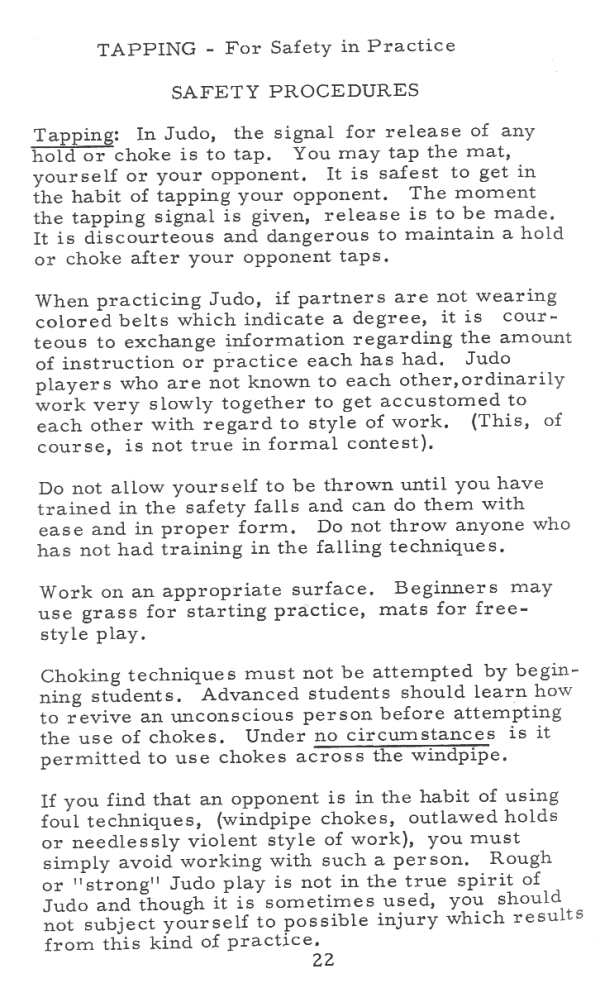jff 022

TAPPING - For Safety in Practice
SAFETY PROCEDURES
Tapping: In Judo, the signal for release of any hołd or choke is to tap. You may tap the mat, yourself or your opponent, It is safest to get in the habit of tapping your opponent. The moment the tapping signal is given, release is to be madę.
It is discourteous and dangerous to maintain a hołd or choke after your opponent taps.
When practicing Judo, if partners are not wearing colored belts which indicate a degree, it is cour-teous to exchange information regarding the amount of instruction or practice each has had. Judo players who are not known to each other.ordinarily work very slowly together to get accustomed to each other with regard to style of work. (This, of course, is not true in formal contest).
Do not allow yourself to be thrown until you have trained in the safety falls and can do them with ease and in proper form. Do not throw anyone who has not had training in the falling techniąues.
Work on an appropriate surface. Beginners may use grass for starting practice, mats for free-style play.
Choking techniąues must not be attempted by begin-ning students. Advanced students should learn how to revive an unconscious person before attempting the use of chokes. Under no circumstances is it permitted to use chokes across the windpipe.
If you find that an opponent is in the habit of using foul techniąues, (windpipe chokes, outlawed holds or needlessly violent style of work), you must simply avoid working with such a person. Rough or "strong" Judo play is not in the true spirit of Judo and though it is sometimes used, you should not subject yourself to possible injury which results from this kind of practice.
22
Wyszukiwarka
Podobne podstrony:
Long-term Support for Customized Solutions In 2008, the Airborne Systems Division of Terma formed a
• ensuring that the person in charge of a unit, plant or installation is aware of
tice, implying option for one of several possibilities, or morę restric-tively, as a critical maieut
INTRODUCTION A Warhammcr Undcrworlds tournament is a way for a group of people (prcfcrably 8 or morc
mobile print2 Telełubbies Mobile 1. Print out the sheets and colour them In. 2.Stick the sheets to a
Energy sector in PolandProduction of electricity In 2012, the electricity generation capacity of Pol
po - intercept (the place in which trend function crosses OY axis (vertical axis), or this is the av
IYC2011 International Ytpar of CHEMISTRY For release 19 Febniary 2010 Element 112 is Named Copei
jff 023 TAPPING FOR SAFETY Photo #1. Left man taps opponent s arm as choke is applied. Release must
jff 116 DIGEST OF GENERAL RULES FOR JUDO CONTEST It is commonly reąuired in Judo contest that the pl
SAFETY IS PART OF SCIENCEGreat for a yariety of ages!Lab- SafetyBoohmcLrh tris m you r textbooQ
THE ROLE OF MEDIA IN ENSURING THE SAFETY Piątek, godz. 11:15-13:15 Unia Europejska a państwa buskieg
Paweł Chorab forth by thc IMO. The plan should include. but not be limited to: detailed safety proce
pg 4 Tank Rescue Safety procedures for recovering a casuafty from a hazardous atmosphere Start resc
00055 ?8eb8f33682dd4ffedb872005d8a4b1 54 Hembree & Zimmer quite a while for discussion of the K
więcej podobnych podstron